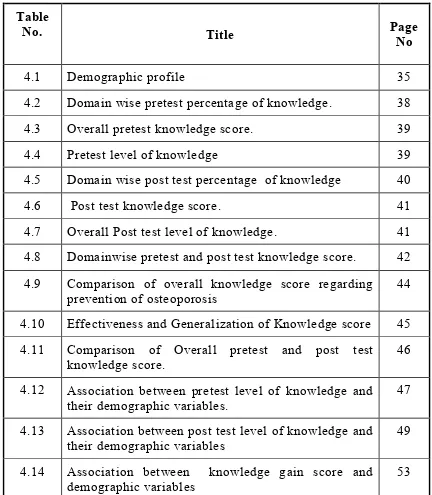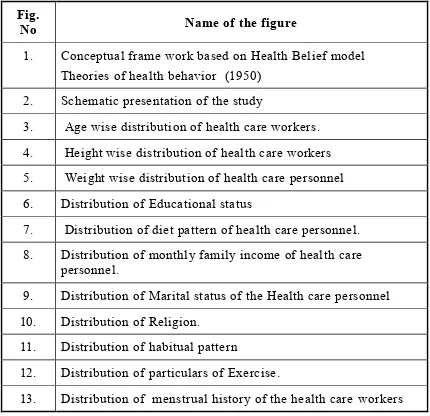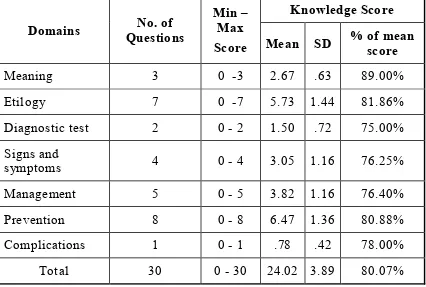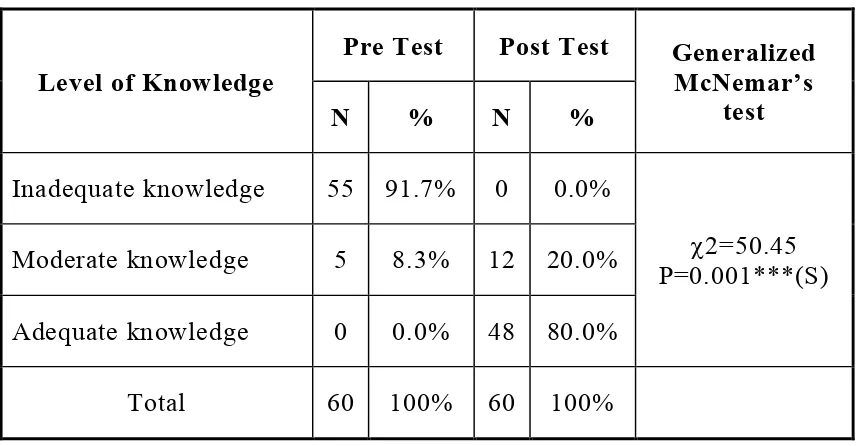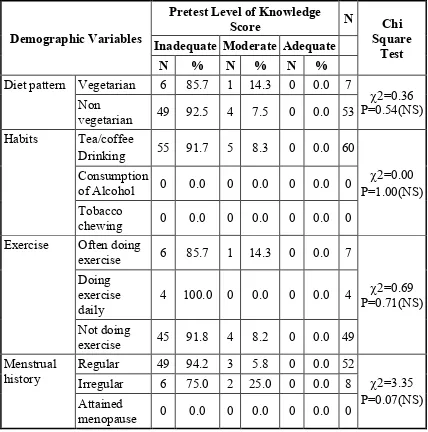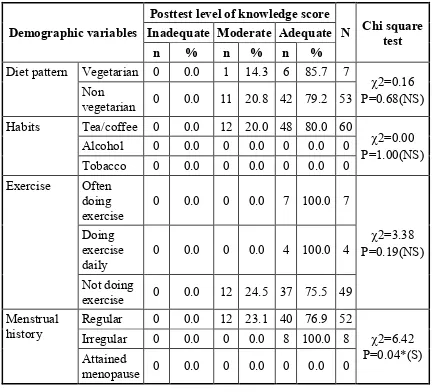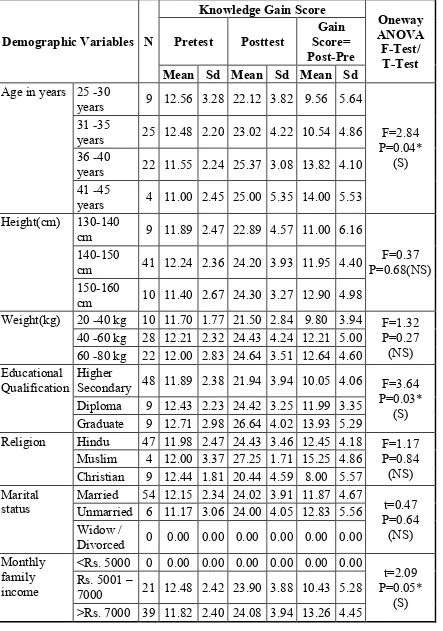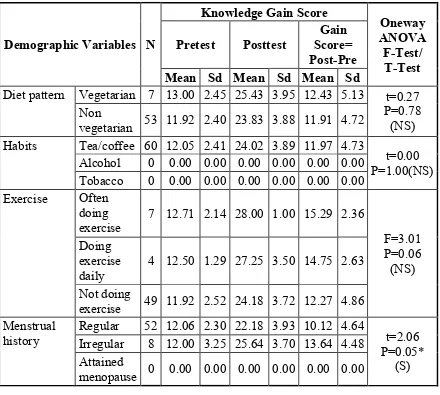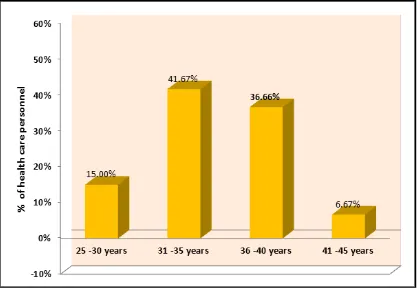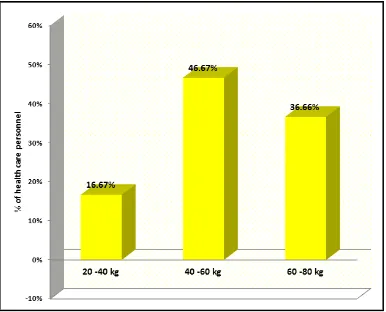1
DISSERTATION ON
A STUDY TO ASSESS THE EFFECTIVENESS OF
STRUCTURED TEACHING PROGRAMME ON
KNOWLEDGE REGARDING PREVENTION OF
OSTEOPOROSIS AMONG HEALTH CARE PERSONNEL
WORKING IN RAJIV GANDHI GOVERNMENT GENERAL
HOSPITAL, CHENNAI-03.
M.SC (NURSING) DEGREE EXAMINATION
BRANCH –I MEDICAL SURGICAL NURSING
COLLEGE OF NURSING
MADRAS MEDICAL COLLEGE, CHENNAI–03.
A dissertation submitted to
THE TAMILNADU DR. M.G.R. MEDICAL UNIVERSITY,
CHENNAI – 600 032.
In partial fulfillment of the requirement for the award of the degree of
MASTER OF SCIENCE IN NURSING
2
A STUDY TO ASSESS THE EFFECTIVENESS OF
STRUCTURED TEACHING PROGRAMME ON
KNOWLEDGE REGARDING PREVENTION OF
OSTEOPOROSIS AMONG HEALTH CARE PERSONNEL
WORKING IN RAJIV GANDHI GENERAL GOVERNMENT
HOSPITAL, CHENNAI-03
Examination : M. Sc (N) Degree Examination
Examination Month and Year :
Branch and Course : I- MEDICAL SURGICAL NURSING
Register No : 301611256
Institution : COLLEGE OF NURSING,
MADRAS MEDICAL COLLEGE CHENNAI-600003.
SD: ---
SD: ---
INTERNAL EXAMINER
EXTERNAL EXAMINER
DATE: ---
DATE: ---
3
A STUDY TO ASSESS THE EFFECTIVENESS OF
STRUCTURED TEACHING PROGRAMME ON
KNOWLEDGE REGARDING PREVENTION OF
OSTEOPOROSIS AMONG HEALTH CARE PERSONNEL
WORKING IN RAJIV GANDHI GOVERNMENT GENERAL
HOSPITAL, CHENNAI-03.
Approved by Dissertation Committee on 11.07.2017NURSING RESEARCH GUIDE ________________
Mrs. A. Thahira Begum, M. Sc(N)., M.B.A., M.Phil.,
Principal
College of Nursing, Madras Medical College, Chennai-03.
CLINICAL SPECIALTY GUIDE ________________
Mrs.V.K.R.Periyarselvi, M.Sc(N).,
Lecturer, Department of Medical Surgical Nursing, College of Nursing, Madras Medical College, Chennai-03.
MEDICAL GUIDE ________________
Prof. N.Deen Muhammed Ismail, M.S.Ortho., D.Ortho.,
Director & Professor
Institute of Orthopeadics and Traumatology,
Madras Medical College & Rajiv Gandhi Government General Hospital, Chennai-03.
A dissertation submitted to
THE TAMILNADU DR. M. G. R. MEDICAL UNIVERSITY,
CHENNAI-600032.
In partial fulfillment of the requirement for the award of the degree of
MASTER OF SCIENCE IN NURSING
4
CERTIFICATE BY THE GUIDE
This is to certify that the dissertation titled, “A STUDY TO ASSESS THE EFFECTIVENESS OF STRUCTURED TEACHING PROGRAMME ON KNOWLEDGE REGARDING PREVENTION OF OSTEOPOROSIS AMONG HEALTH CARE PERSONNEL WORKING IN RAJIV GANDHI GOVERNMENT GENERAL HOSPITAL, CHENNAI-03”, is a bonafide work done by Ms.J.Nancy,
M.Sc Nursing II year student, College of Nursing, Madras Medical College, Chennai-03. submitted to The Tamilnadu Dr.M.G.R. Medical University, Chennai in partial fulfillment of the requirement of the award of the degree of Master of Science in Nursing, Branch-I Medical Surgical Nursing under our guidance and supervision during the academic period from 2016-2018.
Mrs.A.Thahira Begum, M.Sc.(N)., M.BA., M.Phil.,
Principal,
College of Nursing, Madras Medical College, Chennai - 600003.
Dr.R.Jayanthi, M.D., FRCP (Glasg),
Dean,
5
Acknowledgement
I would like to thank the Almighty for his abundant grace, blessings, wisdom, knowledge, guidance, strength and unconditional love showered in completing this study without any interruption
I am thankful to Dr.Jayanthi, MD., FRCP (Glasg)., Madras Medical college,and our respected Prof.Sudha Seshayyan, MS., Vice Principal, Madras Medical College, Chennai, to permitted me to conduct the study in Rajiv Gandhi Government General Hospital..
I express my gratitude to Prof.N.Deen Muhammad Ismail, M.S., Ortho., D.Ortho., Director & Professor, Institute of Orthopaedics and traumatology, Rajiv Gandhi Government General Hospital, Chennai for granting permission to conduct the study and his valuable suggestion.
My sincere thanks to Dr.Hemanth Kumar, M.S.,Ortho., D.Ortho., Associate Professor, Institute of Orthopeadics and Traumatology, Rajiv Gandhi Government General Hospital, Chennai -03, for his suggestion and guidance to complete the study successfully.
It is my privilege to thank Mrs.A.Thahira Begum, M.Sc (N)., M.B.A., M.Phil., Principal, College of Nursing, Madras Medical College, Chennai-03, for her mentorship, valuable guidance, commendable monitoring, role modeling in the field of nursing research.
6
provoking suggestions that has moulded me to conquer the spirit of knowledge for sculpturing my manuscript into thesis.
I am grateful to my specialty guide Mrs.V.K.R.Periyarselvi, M.Sc(N).,
Lecturer, College of Nursing, Madras Medical College, Chennai-03, for constant source of inspiration, encouragement, brain storming ideas, motivation and guidance throughout the study.
My sincere thanks to Medical Surgical Nursing Specialty Lecturer
Mrs. C.S.V. Umalakshmi, M.Sc(N)., Mr.N.Muruganandan, M.Sc(N).,
and Mrs.D.Anandhi, M.Sc(N)., M.B.A., Nursing Tutor, College of Nursing, Madras Medical College for their valuable guidance in completing this study.
I wish to express my gratitude to all the Faculty members of College of Nursing, Madras Medical College, chennai-03, for their valuable guidance in conducting this study.
I am extremely thankful to Dr.A.Vengatesan M.Sc., M.Phil., P.G.D.C.A., Ph.D., (Statistics) former Deputy Director of Medical Education, Madras Medical College, Chennai-03 for suggestion and guidance on statistical analysis.
It is my immense pleasure and privilege to express my gratitude to
Dr.Lizy Sonia, M.Sc(N)., Ph.D., Vice Principal, Apollo College of Nursing and Dr.B.Tamilarasi, M.Sc(N), Ph.D., Principal, Madha College of Nursing, Chennai-95. for validating the tool.
7
My heartfelt thanks to Mr.Prabhukumar, M.A., B.Ed., who helped me by transmitting the tool in Tamil Versions.
My immense thanks to Mr.Sundar, M.A., B.Ed., Assistant professor for editing the Dissertation in English.
I express my heartfelt gratitude to the Nursing Superintendent, Grade I and Staff Nurses of Department of Orthopeadic and Trauma ward, Rajiv Gandhi Government General Hospital, Chenai-03. who have extended their co-operation during the study.
My earnest gratitude to all the health care personnel who have participated in my study for their support and patience to complete my study successfully.
My special and deep thanks to my husband Mr.Jegan, MBE., for his loving support, encouragement, earnest prayers, patience and understanding during the study. I thankful to my daughter Miss.Princy
and my son Mr.William Carey, and my mother Mrs.Pennammal for their constant encouragement and support during the study.
My special and deep thanks to my friend Mrs.L.Rekha for his loving support, earnest prayers and encouragement during the study. I express my deep sense for gratitude to all my friends and well wishers for their immense good will.
I owe my great sense of gratitude to Mr.Jas Ahamed Aslam and
8
Above all, I thank the Almighty for sustaining with His grace every moment of life and especially for the successful completion of this study.
9
ABSTRACT
INTRODUCTION
Osteoporosis is the most common bone disease in humans, representing a major public health problem. It is a silent disease until fractures occur which causes important secondary health problems and even death. Osteoporosis can be prevented, diagnosed, and treated before fractures occur. Prevention, detection, and treatment of osteoporosis should be a mandate of primary care providers.Hence the study was conducted to evaluate the effectiveness of structured teaching programme regarding prevention of osteoporosis among health care personnel working in Rajiv Gandhi Government General Hospital, chennai-03.
OBJECTIVES
The study objectives are to assess the level of knowledge on prevention of osteoporosis among health care personnel, to evaluate the effectiveness of structured teaching program on Knowledge regarding prevention of osteoporosis among health care personnel and to find the association between the knowledge on prevention of osteoporosis among health care personnel and selected demographic variable.
MATERIALS AND METHODS
10
RESULTS
The study results showed that there was a significant differences between the values of pre test40.71% and post test 80.07% level of knowledge regarding the prevention of osteoporosis. The computed t -value 19.61 was very highly significant of the p -value of p=0.001***.
Regarding effectiveness of STP, the overall mean percentage knowledge score in the pre- test was 12.05 and 24.02 in the post test. On an average, in the post test, after having structured teaching program, health care personnel gained 39.90% more knowledge score than pre test score. The statistical paired ‘t’ test indicates that enhancement in the mean percentage knowledge score was found to be significant at (P=0.001**) percent level for all the aspects under study. There was significant association between the gain in knowledge scores and selected demographic variables with age, education status, monthly income and menstrual history at (P=0.001**)
CONCLUSION:
11
TABLE OF CONTENTS
CHAPTER
NO TITLE PAGE NO
I INTRODUCTION 1
1.1 Need for the study 5
1.2 statement of the problem 8
1.3 objectives 8
1.4 operational definition 8
1.5 Assumptions 10
1.6 Research hypothesis 10
1.7 Delimitation of the study 10
1.8 conceptual Framework 11
II REVIEW OF LITERATURE
2.1 Review of related studies. 16
III RESEARCH METHODOLOGY
3.1 Research Approach 26
3.2 Research Design 26
3.3 Setting of the study 27
3.4 Duration of the study 27
3.5/ Study population 27
3.6 Sample 27
3.7 Sample size 27
3.8 Sampling Criteria 28
3.9 Sampling technique 28
3.10 Research variables 28
12
CHAPTER
NO TITLE PAGE NO
3.12 Description and description of the
tool 29
3.13 Human Rights and Ethical
Considerations 31
3.14 Pilot Study 31
3.15Pilot Study Recommendations. 32 3.16 Data collection procedure 32
3.17 Plan for Data Analysis 33
IV DATA ANALYSIS AND
INTERPRETATION
34
V DISCUSSION 55
VI SUMMARY AND
RECOMMENDATIONS
6.1 Summary 59
6.2 Finding 59
6.3 Implication 61
6.4 Recommendation 63
6.5 Conclusion 64
REFERENCES
13
LIST OF TABLES
Table
No. Title Page
No
4.1 Demographic profile 35
4.2 Domain wise pretest percentage of knowledge. 38
4.3 Overall pretest knowledge score. 39
4.4 Pretest level of knowledge 39
4.5 Domain wise post test percentage of knowledge 40
4.6 Post test knowledge score. 41
4.7 Overall Post test level of knowledge. 41 4.8 Domainwise pretest and post test knowledge score. 42 4.9 Comparison of overall knowledge score regarding
prevention of osteoporosis
44
4.10 Effectiveness and Generalization of Knowledge score 45 4.11 Comparison of Overall pretest and post test
knowledge score. 46
4.12 Association between pretest level of knowledge and their demographic variables.
47
4.13 Association between post test level of knowledge and their demographic variables
49
4.14 Association between knowledge gain score and
[image:13.595.81.513.133.628.2]14
LIST OF FIGURES
Fig.
No Name of the figure
1. Conceptual frame work based on Health Belief model Theories of health behavior (1950)
2. Schematic presentation of the study
3. Age wise distribution of health care workers. 4. Height wise distribution of health care workers 5. Weight wise distribution of health care personnel 6. Distribution of Educational status
7. Distribution of diet pattern of health care personnel. 8. Distribution of monthly family income of health care
personnel.
9. Distribution of Marital status of the Health care personnel 10. Distribution of Religion.
11. Distribution of habitual pattern
12. Distribution of particulars of Exercise.
[image:14.595.83.513.135.551.2]15
LIST OF APPENDICES
APPENDIX TITLE
I Copy of letter seeking permission to conduct the study at Rajiv Gandhi Government General Hospital.
II Certificate for Content Validity III Informed Consent Form
IV Certifiate of English Editing V Certificate of Tamil Editing
VI Data Collection Tool (English, Tamil) VII Lesson Plan (English, Tamil)
VIII Coding Sheet
16
LIST OF ABBREVIATIONS
ABBREVIATION EXPANSION
BMD Bone mineral density.
FRAX Fracture Risk Assessment Tool.
DEXA Dual Energy X-ray Absorptiometry.
HBM Health Belief Model.
PTH Parathyroid Hormone.
1
CHAPTER-I
INTRODUCTION
“Love your bones, protect your future”
Bone provide the structure of the human body. Bone health is important to overall health because bones need to be healthy to support everyday life. To be supportive, bones must stay strong and fracture resistant. To resist fracturing, bone strength must be enhanced from a combination of bone quality and bone quantity. Bone quality refers to its architecture and mineralization while bone quantity refers to its mass and density.1
Khan et al, 2001, described that with current technology the quality of bone is more difficult and expensive to determine than the quantity of bone. Therefore bone mineral density (BMD) a measure of bone quantity that is the amount of bone mass per unit area/volume is the most commonly used outcome measure for bone strength used in both clinical and research settings. Small increases in BMD result in large increases in bone strength and a BMD increase of just 5-8% can result in a 64-87% increase in bone strength. This increased bone strength, especially the ability for more bone to be strategically placed at the sites of highest strain can result in increased resistance to fractures. Increasing BMD is the primary focus in promoting and enhancing bone health but if BMD is reduced and becomes too low, then bone health is compromised which can lead to osteoporosis.2
2
account BMD readings at the femoral neck. This figure rises to 52% in women aged 80 years or more.3
Kanis, Melton, et al (1994), highlighted in his thesis that Osteoporosis is a disease in which BMD is 2.5 standard deviations below the young adult mean value. It weakens bones and can result in an increased risk of bone fracture. Bone strength is reduced in individuals with osteoporosis because bone is lost at a higher rate than it is replaced. Osteoporosis deteriorates bone strength before signs and symptoms occur the disease is usually not diagnosed until a bone fracture actually occurs. Although osteoporosis affects the whole skeleton, the most common sites for bone fractures due to osteoporosis are the hip, spine, and wrist. Osteoporosis is a serious and debilitating disease that can have adverse effects on both the quality and quantity of life and osteoporosis and osteoporotic fractures can lower self-esteem, while increasing fear, anxiety and depression, and also lead to increased disability and mortal ity especially with osteoporotic fractures in the hip and spine.4
The BMD tends to achieve its peak value during the third decade of life, usually up to 30 years of age. After 30 years of age, peak BMD has been shown to start decreasing due to age-related bone loss. Therefore the optimal approach for preventing osteoporosis is to maximize peak BMD for the first 30 years of life with adequate weight-bearing physical activity and calcium consumption, for the maintainance of peak BMD.5
3
two fifth of women aged 80 and two thirds of women aged 90. Osteoporosis affects an estimated 75 million people in Europe, USA and Japan for the year of 2000, there were an estimated 9 million new osteoporotic fractures of which 1-6 million were at the hip, 1.7 million were at the forearm and 1.4 million were clinical vertebral fractures.
By the year 2050, the global population of individuals aged ≥65 years is expected to reach to more than 1.5 billion. Assuming a constant age specific risk of hip fracture, the projected number of osteoporotic hip fractures worldwide is estimated to increase from 1.66 million in 1990 to 6.26 million in 2050.
It has been estimated that there was nearly a 25% increases in hip fractures worldwide by 2050, the worldwide incidence of hip fracture in women protected to increase by 310% and 240% in women. In USA by the year 2010, it is estimated that more than 52 million women and men in the same age category if get affected and the current trends continues the figure will climb to more than 61 million by 2020.6
In India, the reasons ascribed for lower bone mineral density include possible genetic differences, nutritional deficiency, and smaller skeletal size; this may be even more relevant for the region where per capita milk consumption is low. It is well known that osteoporosis often remains undiagnosed as a silent disease until a fragility fracture occurs and early detection can prevent fractures. The department of health research, the government of India in its recently included osteoporosis as one of the priority areas in the non communicable diseases7
4
is the first such study from this region of India. They found that the vertebral osteoporosis was found to be much more common than femoral neck osteoporosis, making this group of patients at higher risk of subsequent osteoporotic vertebral compression fracture and future disability if not proactively treated, educated and followed up for proper compliance. Fortunately, most patients did not have any previous fracture despite found to have spinal and hip osteopenia or osteoporosis, meaning thereby that there is a window of opportunity for secondary prevention of new osteoporotic fractures. Food-based approach, physical activity and lifestyle modification through health education may be appropriate for prevention of osteoporosis and risk of fractures.8
5
all of which can contribute to the prevention of the consequences of osteoporosis.9
1.1 NEED FOR THE STUDY
In Rajiv Gandhi Government General hospital more than 25 percent of the health care worker were diagnosed to have osteoporosis and they are all under treatment for osteoporosis. Even though some of the health care work know the risk factors and preventive behaviors but they are unable to follow that in their daily life. Some of the health care workers in the younger group doesn‟t have enough knowledge towards the osteoporosis and its prevention.
The bone mass begins to decrease from the age of 30 so in order to protect against osteoporosis practicing healthy lifestyle and nutritional habits that build bone are especially important. These habits should include consuming recommended amount of calcium and vitamin-D, performing weight- bearing and muscle strengthening exercises especially from childhood and avoiding alcohol and smoking9.
6
Osteoporosis prevention education interventions are given with the intention to provide education and increase osteoporosis knowledge which lead to osteoporosis preventive behaviors, such as weight-bearing physical activity and calcium consumption. The knowledge regarding prevention of osteoporosis provided will increase the knowledge, but the participants should follow the preventive behaviors in their day to day activities in order to prevent the occurrence of the disease11.
Prevention of osteoporosis in the whole population focuses on nutritional and life style changes. The goals include acquiring minimal peak skeletal bone mass and maintaining this bone mass as long as possible. Increasing awareness of the modifiable risk factors for osteoporosis through patient education is an important primary care role. The primary care is provided to the general public by the health care personnel. The health care personnel should have enough knowledge regarding the preventive behaviors and they should have those preventive behaviors.12
India is a sun-rich country, hence deficiency of vitamin D had reported at all age groups. Primary prevention also known as health promotion focuses on preventing osteoporosis and illness with specific preventive measures. Poor nutritional status has adverse effects on the health of a weight-bearing skeleton. As a result risk for fall is higher which may cause fractures and risk for fall is also a direct effect of excessive drinking (International Osteoporosis Foundation, 2012).13
7
The young individuals are not engaging in adequate weight -bearing physical activity and calcium consumption to effectively prevent osteoporosis. Cross sectional studies of college women have found that although approximately eight to nine out of 10 of them knew that adequate weight-bearing physical activity and calcium consumption could prevent osteoporosis, fewer than one out of 10 of them actually engaged in adequate weight-bearing physical activity and calcium consumption. These findings show an absolute need to encourage young individuals, or at least young women, to engage in adequate weight-bearing physical activity and calcium consumption to prevent osteoporosis.14
In Rajiv Gandhi Government General Hospital in the Institute of orthopaedic and Traumatology outpatient department daily more than 10 patients are coming for treatment of osteoporosis. In Master health Checkup department more than 40 people doing their checkup per day. In that, monthly 50% of people are given the report of osteopenia and 25% were give the report of osteoporosis. But the affected people are not taking the ideal treatment for osteoporosis because of lack of awareness and knowledge about the seriousness of that disease.
Nowadays, the emerging of newer disease is common worldwide. But in the management and treatment facilities for that newer disease is not available or it is under research process. In that case the old proverb “prevention is Better than cure” is the best ideal remedy for escaping from those disease. Osteoporosis is one of the diseases which we can prevent it. The life style changes, dietary pattern may enhance quality of the bones and to prevent the disease.
8
bone DEXA scan (dual energy X-ray So the absorptiometry), the early diagnosis and the preventive therapy is very less among the public. Being a medical professional the health care worker also doesn‟t have the awareness to protect them from osteoporosis. Hence, the investigator felt that there is a need to get access to and impact knowledge on prevention and life style change of osteoporosis among Heath care Personnel who are all working in RGGH.
1.2 STATEMENT OF THE PROBLEM
A study to assess the effectiveness of structured teaching programme on knowledge regarding prevention of osteoporosis among health care personnel working in Rajiv Gandhi Government General Hospital, chennai-03.
1.3 OBJECTIVES OF THE STUDY
To assess the pre test level of knowledge on prevention of osteoporosis among health care personnel.
To evaluate the effectiveness of structured teaching program on Knowledge regarding prevention of osteoporosis among health care personnel..
To find the association between the knowledge on prevention of osteoporosis among health care personnel and selected demographic variable.
1.4 OPERATIONAL DEFINITIONS
Assess9
EffectivenessIt refers to gain in knowledge on prevention of osteoporosis among health care personnel as determined by significant difference between pre test and post test knowledge scores.
Structured Teaching Programme
It refers to a systematically developed teaching programme designed for health care personnel about the meaning, risk factors, signs and symptoms, diagnosis, management, complication and lifestyle modifications and dietary patterns to give information on prevention of osteoporosis.
Knowledge
It refers to the correct response given by the health care personnel on the pre test about prevention of osteoporosis.
Prevention
It refers to the implementation of the knowledge on prevention of osteoporosis among health care personnel after structured teaching programme and to protect them from osteoporosis.
Osteoporosis
It is a systemic skeletal disorder characterized by low bone mass and micro-architectural deterioration of bone tissue leading to enhanced bone fragility and a consequent increase in fracture risk.
Health Care Personnel
10
1.6 ASSUMPTIONS
The study is based on the following assumptions.
1) The education may enhance the knowledge of health care personnel regarding prevention of osteoporosis.
2) The information on prevention of osteoporosis may be helpful for the health care personnel to reduce the risk of osteoporosis.
1.5 HYPOTHESIS
H1: There will be significant effectiveness of Structured teaching programme in providing the knowledge on the prevention of osteoporosis among health care personnel.
H2: There will be significant difference between pre test and post test knowledge scores of health care personnel on prevention of osteoporosis.
1.7 DELIMITATIONS
1) The study is only for Female nursing assisstants
2) The data collection period is for 4 weeks.
3) Study is limited to only 60 samples.
4) The health care personnel who are all not under the treatment of osteoporosis.
11
1.8 CONCEPTUAL FRAMEWORK
A conceptual framework is a theoretical approach to study the problems that are scientifically based which emphasis the selection, arrangement and classification of itsconcepts. A conceptual framework broadly explains phenomena of interest, expresses assumption and reflects a philosophical stance and it explains the relationship between the variable in the diagrammatic representation.
The conceptual framework for this study is derived from One of the first theories of health behavior, the health belief model was developed in the 1950s by social psychologists Irwin M. Rosenstock, Godfrey M. Hochbaum, S. Stephen Kegeles, and Howard Leventhal at the U.S. Public Health Service. It remains one of the best known and most widely used theories in health behavior research.15
The present study aims at evaluating the effectiveness of structured teaching programme on knowledge regarding prevention of osteoporosis among health care personnel.
In this study, the health belief model was used. Here it suggests that people's beliefs about health problems, perceived benefits of action and barriers to action, and self-efficacy engagement or lack of engagement in health-promoting behavior. A stimulus or cue to action, must also be present in order to trigger the health-promoting behavior. The theoretical constructs are
1) Perceived severity.
2) Perceived susceptibility.
3) Perceived benefits.
12
5) Modifying variables.6) Cues to action.
7) Self –efficacy.
PERCEIVED SEVERITY
Perceived severity refers to the subjective assessment of the severity of a health problem and its potential consequences. The health belief model proposes that individuals who perceive a given health problem as serious are more likely to engage in behaviors to prevent the health problem from occurring. Perceived seriousness encompasses beliefs about the disease itself, whether it is life-threatening or may cause disability or pain as well as broader impacts of the disease on functioning in work and social roles.16
Here in this study the perceived severity is the knowledge regarding the osteoporosis disease and its consequences and the physical disabilities and the impact of the disease process in the health of an individual.
PERCEIVED SUSCEPTIBILITY
13
The combination of perceived severity and perceived susceptibility is referred to as perceived threat. Perceived severity and perceived susceptibility to a given health condition depend on knowledge about the condition. The health belief model predicts that higher perceived threat leads to higher likelihood of engagement in health-promoting behaviors.
Here in this study the perceived susceptibility is the individual behavior which can lead to occurrence of the disease in future.
PERCEIVED BENEFITS
Health-related behaviors are also influenced by the perceived benefits of taking action. Perceived benefits refer to an individual's assessment of the value or efficacy of engaging in a health-promoting behavior to decrease risk of disease. If an individual believes that a particular action will reduce susceptibility to a health problem or decrease its seriousness, then he or she is likely to engage in that behavior regardless of objective facts regarding the effectiveness of the action.
The knowledge gained from the structured health education programme which provide the knowledge regarding the be havior, life style modification, the diet and the exercises to be performed daily in order to prevent the osteoporosis disease.
Perceived Barriers
Health-related behaviors are also a function of perceived barriers to taking action. Perceived barriers refer to an individual's assessment of the obstacles to behavior change. Even if an individual perceives a health condition as threatening and believes that a particular action will effectively reduce the threat, barriers may prevent engagement in the health-promoting behavior.
14
health education regarding prevention of osteoporosis must outweigh the perceived barriers in order for behavior change to occur.
Modifying Variables
Individual characteristics, including demographic, psychosocial, and structural variables, can affect perceptions (perceived seriousness, susceptibility, benefits, and barriers) of health-related behaviors. Demographic variables include age, sex, race, ethnicity, and education, among others.Psychosocial variables include personality, social class, and peer and reference group pressure, among others.
Structural variables include knowledge about the disease and prior contact with the disease, among other factors. The health belief model suggests that modifying variables affect health-related behaviors indirectly by affecting perceived seriousness, susceptibility, benefits, and barriers.
The limited exposure and the inadequate knowledge regarding the prevention aspects of osteoporosis can be modified by the structured teaching programme regarding the disease process and the complications of osteoporosis and the easy and earlier measures to be adopted in order to avoid the occurrence of the osteoporosis.
Cues to Action
15
The structured teaching programme regarding the prevention of osteoporosis by life style modifications is the cue to the health care personnel in order to trigger the health promoting behaviours.
Self-Efficacy
Self-efficacy was added to the four components of the health belief model (perceived susceptibility, seriousness, benefits, and barriers) in 1988. Self-efficacy refers to an individual's perception of his or her competence to successfully perform a behavior. Self-efficacy was added to the health belief model in an attempt to better explain individual differences in health behaviors. Eventually, the health belief model was applied to more substantial, long-term behavior change such as diet modification, exercise, and smoking. Developers of the model recognized that confidence in one's ability to effect change in outcomes (self -efficacy) was a key component of health behavior change
16
CHAPTER-II
REVIEW OF LITERATURE
Literature review can serve a number of important functions in the research process and they also play a critical role for nurses seeking to develop an evidence based practice. Literature reviews can inspire new research ideas and help to lay the foundation for studies. A literature review is a crucial early task for most quantitative resear chers.
A literature review in a quantitative study can help to shape research questions contribute to the argument about the need for a new study suggest appropriate methods and a point to a conceptual or theoretical framework.
The sources to obtain more information on the selected topic were pubmed search, journals, books, unpublished thesis and internet. For the the purpose of logical sequence the chapter is divided into
1) Studies related to overview of osteoporosis.
2) Studies related to etiological and risk factors of osteoporosis
3) Studies related to effectiveness of structured teaching program.
4) Studies related to creating awareness on prevention of osteoporosis by structured teaching program.
I. STUDIES RELATED TO THE OVERVIEW OF
OSTEOPOROSIS:
17
lasting disability, impaired quality of life, and increased mortality, with enormous medical and heavy personnel burden on both the patient‟s and nation‟s economy. Osteoporosis can be diagnosed and prevented with effective treatments, before fractures occur. Therefore, the prevention, detection, and treatment of osteoporosis should be a mandate of primary healthcare providers.18
Willem F. Lems, Hennie G. Raterman, (2017) has written on a journal of Critical issues and current challenges in osteoporosis and fracture prevention and stated that Osteoporosis is a silent disease with increasing prevalence due to the global ageing population. Decreased bone strength and bone quality is the hallmark of osteoporosis which leads to an increased risk of fragility fractures in elderly. It has been estimated that approximately 50% of women will suffer during their lifetime from an osteoporotic fracture. This must be considered as a major health concern, as it has previously been established that fragility fracture has been associated with decreased quality of life due to increased disability, more frequent hospital admission and most importantly osteoporotic fractures have been related to an augmented mortality risk.19
18
L.G. Rao and A.V. Rao (2016) has declared that oxidative stress due to reactive oxygen species that are shown to cause the development of osteoporosis may be prevented by supplementation with the antioxidants lycopene and polyphenols. Results of in vitro studies in osteoblasts and osteoclasts, animal intervention studies, epidemiological studies and clinical intervention studies on lycopene and polyphenols are evidence for their potential use as alternative or complementary agent with other established drugs approved for the prevention or treatment of osteoporosis in women.21
Liu W , Yang LH , Kong XC ,et al (2015) conducted a Meta-analysis of osteoporosis fracture risks, medication and treatment. Osteoporosis is a brittle bone disease that can cause fractures mostly in older men and women. The methods of Medline, Embase, and CINAHL were literature searched for these observational studies from year 1998 to 2009, and up to 2015. The results of meta-analysis of osteoporosis research on fractures of postmenopausal women and men are presented. The use of bisphosphonate therapy for osteoporosis has bee n described with other drugs. 22
19
II. STUDIES RELATED TO ETILOGICAL AND RISK
FACTORS OF OSTEOPOROSIS:
Mohamad NV (2016) has conducted a study to determine that Age-related estrogen and testosterone deficiency was the most important factor of bone loss in elderly men. Osteoporosis is a condi tion causing significant morbidity and mortality in the elderly population worldwide. Age-related testosterone deficiency is the most important factor of bone loss in elderly men. Human experimental studies showed that estrogen was needed in suppressing bone resorption, but both androgen and estrogen were indispensable for bone formation. As a conclusion, maintaining optimal level of androgen is essential in preventing osteoporosis and its complications in elderly men and women. 24
Horita N (2016) has conducted a study to clarify corticosteroids cause serious adverse effects such as osteoporosis, diabetes, and immune suppression. Thus, physicians have to properly assess the risk of adverse effects to prevent them. In this review, he discuss the risk of osteoporosis by corticosteroids that are prescribed for pulmonary diseases. Inhaled corticosteroids are not serious risk factors of osteoporosis. If systemic corticosteroids are planned to be administrated in the prednisolone equivalent dosage of 5 mg/day or more for three months or longer, risk of bone fracture have to be assessed regardless of the primary pulmonary disease. If necessary, prophylactic agent such as bisphosphonates should be prescript.25
20
low and adherence to treatment is poor. Addressing this treatment gap through measures such as fracture liaison services, which provide a coordinated and cost-effective strategy for secondary fracture prevention, is an important future priority.26
Compston J (2016) has conducted a study relating the risk factors of osteoporosis that loss of muscle or bone mass occurs with ageing, immobility and in association with a variety of systemic diseases. Pharmacological interventions to reduce fracture risk are exploring new mechanisms of action, in particular the uncoupling of bone resorption and formation. Emerging key issues for clinical trial design include adequate phenotyping of patients (personalised medicine), optimisation of the physiological background (multimodal approach) and the use of meaningful and robust outcomes relevant to daily clinical practice. At present, effective treatments that combine beneficial effects on both muscle and bone are lacking, although this is an important target for the future.27
Del Puente A, Esposito A (2016) has conducted a study on Osteoporosis represents a relevant health issue, being the first cause of bone fractures in the elderly with subsequent implications in terms of survival and social costs. The improved knowledge about the physiopathology of this disease has led to a new definition of Osteoporosis, which shifts the attention from the "decrease in bone mass"to several elements related to what has globally been defined as bone quality. In fact, it has been shown that clinical risk factors affecting bone homeostasis coincide with osteoporosis risk factors. The evaluation of such clinical risk factors is an important element in the assessment of the global fracture risk. 28
21
screening to identify osteoporosis in women aged 65 years and older. Risk assessment is recommended to guide BMD screening in postmenopausal women under age 65.. Based on longitudinal studies of incident osteoporosis and fracture in postmenopausal women, an initial BMD test should be ordered for all women aged 65, and the frequency of re-screening should be based on age and BMD T score (more frequent testing for older age and lower T score). Although clinical practice guidelines recommend BMD screening according to risk factors for fracture in postmenopausal women under age 65, no standard approach to risk assessment exists.
Singla R, Gupta Y (2015) conducted a study on People with diabetes shows higher prevalence of musculoskeletal diseases as compared to general population. Diabetes affects all components of musculoskeletal system viz. muscles, bones and connective tissue. Diabetic myonecrosis is a unique condition seen only in people with diabetes. Other diseases include amyotrophy, osteoporosis and increased fracture risk, carpal tunnel syndrome, adhesive capsulitis of shoulder, trigger finger and limited joint mobility. Like all other chronic dise ases, musculoskeletal diseases impact quality of life negatively.30
22
Patricia Clark (2015) has conducted a study on Risk Perception and Knowledge about Osteoporosis to identify the level of knowledge and risk perception of developing osteoporosis and its association with socio-demographic variables and risk factors. Individuals older than 18 years living in Mexico City were surveyed. The most important variables associated with the perception of risk were age (<45 years), gender (female), and family history of osteoporosis. Individuals know a lot about osteoporosis, but they engage in risky behaviors and lack perception of their risk in developing it. Interventions should aim at raising awareness about personal responsibility and about the likelihood of developing this condition.32
III. STUDIES RELATED TO EFFECTIVNESS OF
STRUCTURED TEACHING PROGRAM
Nisha M.Varghese1 (2013) has conducted a quasi experimental study to assess and compare the knowledge, attitude and expressed practices of working women regarding prevention of osteoporosis. Positive significant relationship (r=0.59) was found between post test knowledge and attitude of working women in experimental group. A significant association was found between level of pos test knowledge with religion (t=7.55), post test attitude with religion (t=10.04) and source of knowledge (t=5.25) in experimental group.33
23
IV. STUDIES RELATED TO PREVENTION OF
OSTEOPOROSIS
Ali Khani Jeihooni (2018) has conducted a quasi case study on the Effect of a Prevention Program Based On Health Belief Model on Osteoporosis. A questionnaire consisting of demographic information, Health Belief Model (HBM) constructs was used to measure nutrition and walking performance for prevention of osteoporosis before, immediately after intervention and after four months. Experimental and the control group, respectively, immediately and Four months after the intervention, the mean scores of the health belief model components and nutritional and walking performance in experimental group was better than the control group.35
Seyedeh Narjes Razavi (2017) by Considering the importance of preventive education in adolescence, a study was performed to determine the effect of health education, based on health belief model, on self-efficacy in prevention of osteoporosis in female adolescents. Results of this study showed that behavioral models, such as the health belief model, could provide a framework for improvement of education in the field of nutritional efficacy for the prevention of osteoporosis.36
24
Testa G, Pavone V (2015) conducted a study on Osteoporosis is the most common bone disease, affecting millions of people and causing a high risk of fractures and a loss of quality of life. The purpose of this review is to overview osteoporosis, including its definition, etiology, and incidence, and then provide some information on possible dietary strategies for optimizing bone health and preventing osteoporosis. A correct diet to prevent osteoporosis should contain adequate amounts of calcium, vitamins D and K, protein, and fatty acids.38
Noordin.S, Glowacki.Z (2015) has conducted a study on Parathyroid hormone and its receptor gene polymorphisms: implications in osteoporosis and in fracture healing. Genetic factors are associated with osteoporosis by influencing bone mineral density (BMD), bone turnover, calcium homeostasis, and susceptibility to osteoporotic fractures. Polymorphisms in genes encoding PTH may contribute to genetic regulation of BMD and thus susceptibility to fracture risk. PTH stimulates the proliferation of osteoprogenitor cells, production of alkaline phosphates, and bone matrix proteins that contribute to hard callus formation and increases strength at the site of fractured bone. During remodeling, PTH promotes osteoclastogenesis restoring the original shape, structure, and mechanical strength of the bone. Some PTH polymorphisms have shown an association with fracture risk.39
25
fractures (screening program) and therapy (use of economic and effective medications with low side effects). Novel medications are undergoing clinical testing and a "healing" of bone reduction with restoration of the normal bone structure.40
26
CHAPTER –III
METHODOLOGY
This chapter deals with the description of research methodology adopted by the investigator. Methodology is a systematic way to solve research problems. It helps the researcher to project a blue print of the research undertaken. Research methodology involves the systematic procedure by the researcher, which starts from initial identification of the problem to its final conclusion. The methodology of research indicates the general pattern of organizing the procedure for gathering valid and reliable data for the purpose of investigation. This study was undertaken to assess the effectiveness of structured teaching programme on knowledge regarding prevention of osteoporosis among health care personnel working in Rajiv Gandhi government general hospital.
This chapter includes research approach, research design, settings of the study, population, sampling technique, criteria for selection of samples, sample size, description of the tool, validity of the t ool, pilot study and procedure for data collection and plan for data analysis.
3.1 RESEARCH APPROACH
The research approach was quantitative
3.2 RESEARCH DESIGN
Descriptive research design of one group pre-test and post-test design was selected in order to evaluate the effectiveness of structured teaching programme. The research design is represented diagrammatically as follows,
O1 X O2
27
Where,O1 - Pre test O2 – Post test
X - Structured teaching programme on prevention of osteoporosis.
3. 3 STUDY SETTINGS
The study was conducted in all the wards of Rajiv Gandhi government general hospital, chennai-03. It is the one of the apex institution in south East Asia. This hospital has almost all specialties and super specialties where tremendous education and pioneering research are carried out.
3.4 DURATION OF THE STUDY
4 weeks.(2.1.18 to 27.1.18)3.5 STUDY POPULATION
Target populationThe health care personnel working in Rajiv Gandhi Government General Hospital.chennai-03.
Accessible population
The health care personnel available during the period of data collection.
3.6 SAMPLE
The health care personnel working in Rajiv Gandhi Government General Hospital.ch-03.
3.7 SAMPLE SIZE
28
3.8 SAMPLING CRITERIA
3.8.1 Inclusion criteria
1) Female Nursing Assistants in the age group of 25 to 45 years.
2) Female Nursing Assistants who are willing to participate.
3) Health care personnel who can understand Tamil or English.
4) Female Nursing Assistants who have the vague symptoms of back pain, shoulder pain and knee pain.
3.8.2 Exclusion criteria
1) Health care personnel of male gender.
2) Those who are all not available at the time of study.
3) Female Nursing Assistants who were taking treatment for osteoporosis.
4) Female Nursing Assistants already attended program related to osteoporosis.
3.9 SAMPLING TECHNIQUE
The sampling technique used in this study was non-probability purposive sampling.
3.10 RESEARCH VARIABLES
Independent Variables (IV) : Knowledge about the level of knowledge on prevention of Osteoporosis.
Dependent Variables (DV) : Structured teaching programme.
29
3.11 DESCRIPTION OF DATA COLLECTION TOOL
The tool prepared in the study was based on the information gathered from the Review of literature, objectives of the study. An interview was conducted by using Interview schedule to collect the data.
3.12 DEVELOPMENT AND DESCRIPTION OF THE TOOL
The researcher developed the tool on the basis of objectives of the study, Tool was developed after extensive review of literature from various textbook journals, internets and discussion and guidance from the experts in the field of nursing and medical experts in Rajiv Gandhi government general hospital and personal experience of researcher in the field and statistician were consulted for the development of tool. The tool was developed in English and translated in to tamil. Congruency was maintained in translation.TOOL CONSISTS OF TWO SECTIONS
Section - AIt consist of 14 semi structured questions to assess demographic variables of health care personnel includes the basic information like age, religion, marital status, educational status, monthly income, height, weight and body mass index and menstrual history.
Section –B
Assessment of Knowledge
30
Categories of the semi structure Questionaire:
3.12.1 Scoring interpretation
An interview schedule was used to assess the knowledge on prevention of osteoporosis among health care personnel. It contains 30 multiple choice questions and scores were divided according to the aspect wise as follows.
Each correct option carries „1‟ mark.
Incorrect option carries „0‟ mark.
Based on the score, the percentage was calculated as follows:- Obtained score
Percentage = --- x 100 Total score
S. No CATEGORIES TOTAL
ITEMS PERCENTAGE
1. Meaning 3 10%
2. Etiology 7 23.3%
3. Diagnostic test 2 6.67%
4. Signs and symptoms 4 13.3%
5. Management 5 16.67%
6. Prevention 8 26.67%
7. Complication 1 3.33%
31
Based on the percentage, the level of knowledge was interpreted as Grade 1 2 and 3.
3.12.2 VALIDITY OF THE TOOL
The tool was validated by panel of Doctors expert in orthopedics and faculty members in Medical Surgical nursing experts. Few suggestions were given by experts and the tool was modified accordingly.
3.12.3 RELIABILITY OF THE TOOL
The reliability of the tool was checked by using test retest method and the reliability value for knowledge scale was r = 0.77. This show that the tool was highly reliable and feasible for conducting the main study.
3.13 HUMAN RIGHTS AND ETHICAL CONSIDERATIONS
The study was approved by the ethical committee constituted by the college. Permission was obtained from the Head of the institution to conduct the study. Informed consent was obtained from the participant of health care personnel who participated in the study.3.14 PILOT STUDY
32
investigator to complete the interview with one sample. The results revealed that the tool was feasible and easy to administer.
3.15 PILOT STUDY RECOMMENDATIONS
The tool was feasible and main study was carried out without any modification after pilot study. Pilot study is a trial run for the main study, to test the reliability, practicability and feasibility of the study. The samples on which the pilot study was conducted were excluded in the main study.
3.16 DATA COLLECTION PROCEDURE
Formal permission to conduct the pilot study and main study was obtained from the Dean and Director of orthopedics in Rajiv Gandhi government general hospital, chennai. The period of the study was extended for four weeks, the data was collected from Monday to Saturday 8am to 4 pm. Using non probability purposive sampling technique 60 samples were selected who fulfilled the selection criteria.
The investigator introduced her to the selected sample of the health care worker and written consent was obtained from each participant after giving assurance of confidentiality. Then the workers were assessed about the knowledge of prevention of osteoporosis by use of semi structure questionnaire. Each day data was collected from available samples and the samples of 3 or 5 samples were gathered as a group.
33
understanding and doubts were clarified and a booklet were given to each health care worker at the end of the discussion.
After 3 days of interval post test was conducted for 25 minutes among the same samples using the same questionnaire and evaluated the effectiveness of structured teaching programme Rajiv Gandhi government general hospital.chennai.
3.17 PLAN FOR DATA ANALYSIS
Descriptive and inferential statistics were used for data analysis.
3.17.1 Descriptive Statistics
1. Frequency and percentage distribution was used to assess demographic variables and level knowledge of prevention of osteoporosis.
2. Frequency, percentage distribution, mean and standard deviation was used toassess level of knowledge among health care personnel.
3.17.2 Inferential Statistics
1) Quantitative knowledge score in pretest and posttest were compared using student‟s paired t-test.
2) Qualitative level of knowledge in pretest and post test were compared using Stuart-Maxwell test /extended Mc Nemar test
3) Association between knowledge gain score and demographic variables are assessed using one way ANOVA F-test and student independent t –test.
34
CHAPTER –IV
DATA ANALYSIS AND INTERPRETATION
Data analysis and interpretation is the core step in research process. The importance of analysis and interpretation of the collected data is to systematically organize, classify and summarize it, so that the results can be interpreted and comprehended to give all the answers that triggered the research. This chapter deals with analysis and interpretation of data collected from 60 Health care personnel worki ng in Rajiv Gandhi Government General Hospital, Chennai-03. The data collected were edited tabulated, analyzed, interpreted and the findings were presented in the forms of tables and figures.
ORGANIZATION OF DATA
The data has been tabulated and analyzed according to the objectives and interpreted in the following sections.
Section-A: Distribution of the demographic variables of health care personnel working in Rajiv Gandhi Government General Hospital.
Section-B: Assessment of pre test level of knowledge of health care personnel towards prevention of osteoporosis.
Section-C: comparison of pretest and post test knowledge of health care personnel towards prevention of osteoporosis.
Section D: Assessment of the effectiveness of the structured teaching programme regarding prevention of osteoporosis.
35
SECTION-A: DISTRIBUTION OF THE DEMOGRAPHIC
VARIABLES OF HEALTH CARE PERSONNEL WORKING IN RAJIV GANDHI GOVERNMENT GENERAL HOSPITAL.
Table 4.1 Frequency and percentage distribution of demographic variables of Health Care Personnel
Demographic Variables No. of Health Care Personnel (N) %
Age in years 25 -30 years 9 15.00
31 -35 years 25 41.67
36 -40 years 22 36.66
41 -45 years 4 6.67
Height 130-140 cms 9 15.00
140-150 cms 41 68.33
150-160 cms 10 16.67
Weight 20 -40 kgs 10 16.67
40 -60 kgs 28 46.67
60 -80 kgs 22 36.66
Educational
Qualification Secondary education 46 76.66
Diploma 7 11.67
Graduate 7 11.67
Religion Hindu 47 78.33
Muslim 4 6.67
Christian 9 15.00
Marital status Married 54 90.00
Unmarried 6 10.00
Widow /
Divorced 0 0.00
Monthly family
income <Rs. 5000 Rs. 5001 – 7000 21 0 35.00 0.00
>Rs. 7000 39 65.00
Diet pattern Vegetarian 7 11.67
Non vegetarian 53 88.33
Habits Tea/coffee
drinking 60 100.00
Alcohol
consumption 0 0.00
36
Demographic Variables No. of Health Care Personnel (N) %
Exercise Often doing
exercise 7 11.67
Doing exercise
daily 4 6.67
Not doing
exercise 49 81.66
Menstrual history Regular 52 86.67
Irregular 8 13.33
Attained
menopause 0 0.00
Analysis of demographic variables presented in tables and explicated in different plots. Table 4.1 shows the frequency and percentage distribution of the demographic variables of health care personnel.
The health care worker age was divide into four age groups. It reveals distribute age from 36-40 years is 22(36.66%),the age from 31-35 years is 25( 41.67%), the age from 25-30 years is 9( 15%).
The health care personnel height was divide into three groups. The height from 150-160 cm were 10(16.67%) and the height 140-150 cm were 41(68.33%) and the height from 130-140 cm were 9(15%).
The health care personnel weight is divide into three groups. The weight from 60-80 kg were 22(36.66%)and the weight from 40-60 kg were 28(46.67%) and the weight of 20-40 kg were 10(16.67%).
Educational status divided into three groups. Higher secondary, Diploma and Graduate. With respect to the education 46(76.66%) had higher secondary education, 7(11.67%) had diploma qualification and 7(11.67%) had Graduation.
37
chart of pictorial distribution. With respect to religion, 47(78.33%) belongs to Hinduism, 4(6.67%) belongs to Muslims and 9(15%) belongs to Christian.
Considering the marital status of the health care personnel 54(90%) were Married, 6(10%) were Unmarried and none of them were widow or divorced. But majority of them married.
The health care personnel being working n the Government sector, they divided into three groups according to the salary they paid monthly. In that 39(65%) of health workers paid above 7000 salary, 21(35%), and 21(35%) health personnel paid between 5000-7000 and none of them paid less than 5000.
On the basis of the diet pattern divided into two groups vegetarian and Non vegetarian. In that 53(88.33%) were belongs to non vegetarian and 7(11.67%) were belongs to vegetarian.
Based on their habits divided into three groups those who drinks tea or coffee, consumption of alcohol and tobacco chewing. In this 60 (100%) had the habit of drinking tea and coffee and none of them had the habit of consuming alcohol and tobacco chewing.
Regarding the Exercise the health care personnel were divide into three groups. Figure 11 bar diagram reflects the distributes exercise among them. In this 7(11.67%) of health care personnel had the habit of often doing the exercises, 4(6.67%) are doing exercises daily and 49(81.66%) are not doing exercises.
38
SECTION –B ASSESSMENT OF PRE TEST LEVEL OF
KNOWLEDGE OF HEALTH CARE PERSONNEL TOWARDS
PREVENTION OF OSTEOPOROSIS
Table-4.2 Frequency and percentage distribution of each domain wise pre test level of knowledge score
Table 4.2 depicts each domain wise pre-test level of knowledge on prevention of osteoporosis among health care personnel. It has been found that percentage of mean score on the knowledge aspects of osteoporosis is higher than the prevention aspects of the osteoporosis. The response dents are having maximum percent of mean score on the following criteria‟s like meaning (46.67%), etiology (43.14%), diagnostic test (46.50%), signs and symptoms (36.75%), management (34.60%) and complications (43.00%). But in case of management and prevention of osteoporosis, the health care personnel are having least knowledge score of 34.60% and 38.30% respectively.
Domains No. of
Questions
Min – Max Score
Knowledge Score
Mean SD % of mean score
Meaning 3 0 -3 1.40 .64 46.67%
Etilogy 7 0 -7 3.02 1.11 43.14%
Diagnostic test 2 0 - 2 .93 .63 46.50%
Signs and
symptoms 4 0 - 4 1.47 .95 36.75%
Management 5 0 - 5 1.73 .86 34.60%
Prevention 8 0 - 8 3.07 1.06 38.38%
Complications 1 0 - 1 .43 .53 43.00%
39
Table 4.3: Frequency and percentage distribution of overall pretest knowledge score
Table 4.4 Frequency and percentage distribution of pretest level of knowledge
Level of
knowledge No. of health care personnel %
Inadequate knowledge 55 91.7%
Moderate knowledge 5 8.3%
Adequate knowledge 0 0.0%
Total 60 100%
Table No.4 shows the level of knowledge regarding prevention of osteoporosis among health care personnel. In general 91.7% of health care personnel are having inadequate knowledge ,8.3% of them having moderate knowledge and none of them are having adequate knowledge.
No. of questions
Min – Max score
Knowledge Score
Mean ±SD
score %
40
SECTION-C: COMPARISON OF PRETEST AND POST TEST
KNOWLEDGE OF HEALTH CARE PERSONNEL
[image:56.595.86.512.183.470.2]TOWARDS PREVENTION OF OSTEOPOROSIS.
Table-4.5: Frequency and percentage distribution of each domain wise Post test level of knowledge on prevention of osteoporosis
Table 4.5 represents each domain wise post-test percentage of knowledge on prevention of osteoporosis among health care personnel. In this table it describes the response dents after attending structured teaching programme the percentage of mean score has increased and higher than the pre test level of knowledge. They are having most knowledge in meaning (89.00%), etiology(81.86%), diagnostic test(75.00%), signs and symptoms (76.25%), complications(78.00%) and in the prevention aspects it shows knowledge gain is up to (80.88%) from (38.38%) in the pre test value.
Domains Questions No. of
Min – Max Score
Knowledge Score
Mean SD % of mean score
Meaning 3 0 -3 2.67 .63 89.00%
Etilogy 7 0 -7 5.73 1.44 81.86%
Diagnostic test 2 0 - 2 1.50 .72 75.00% Signs and
symptoms 4 0 - 4 3.05 1.16 76.25%
Management 5 0 - 5 3.82 1.16 76.40%
Prevention 8 0 - 8 6.47 1.36 80.88%
Complications 1 0 - 1 .78 .42 78.00%
41
Table-4.6: Frequency and percentage distribution of Post test level of knowledge on prevention of osteoporosis
Posttest Level of Knowledge
Level of Knowledge N Percentage %
Inadequate knowledge 0 0.0%
Moderate knowledge 12 20.0%
Adequate knowledge 48 80.0%
Total 60 100%
Table No. 4.6 depicts the post-test level of knowledge about prevention of osteoporosis among health care personnel. After attending the structured teaching programme assessment of the level of knowledge of prevention of osteoporosis reveals that 48(80%) are having adequate knowledge ,12(20%) of them having moderate level of knowledge score and none of them are having inadequate level of knowledge score about prevention of osteoporosis.
Table-4.7: Overall Post Test Knowledge Score
No. of questions
Min – Max score
knowledge score
Mean ±SD
score %
Overall score 30 0 -30 24.02±3.89 80.07%
42
Table-4.8 :Frequency and percentage distribution of each domain wise pretest and posttest percentage of knowledge gain score
Domains Posttest
knowledge
Pretest
knowledge % of knowledge gain
Meaning 89.00% 46.67% 42.33%
Etilogy 81.86% 43.14% 38.72%
Diagnostic test 75.00% 46.50% 28.50%
Signs and
symptoms 76.25% 36.75% 39.50%
Management 76.40% 34.60% 41.80%
Prevention 80.88% 38.38% 42.50%
Complications 78.00% 43.00% 35.00%
Total 80.07% 40.17% 39.90%
Table 4.8 shows each domain wise knowledge gain score among the health personnel. This table shows that the purpose of the study is to merge the knowledge of practices to followed to prevent osteoporosis. Significance of difference between pretest and post test score calculated using student paired t-test.
Knowledge about Meaning, in pretest , health personnel are having 1.40 score since in post test they are having 2.67score. Difference is 1.27 . This difference is large and it is statistically significant difference.
Knowledge about Etiology, in pretest, health personnel are having 3.02 score where in post test they are having 5.73 score. Difference is 2.71 . This difference is large and it is statistically significant difference.
43
Difference is 0.57. This difference is large and it is statistically significant difference.
Knowledge on Signs and symptoms, in pretest, health personn
